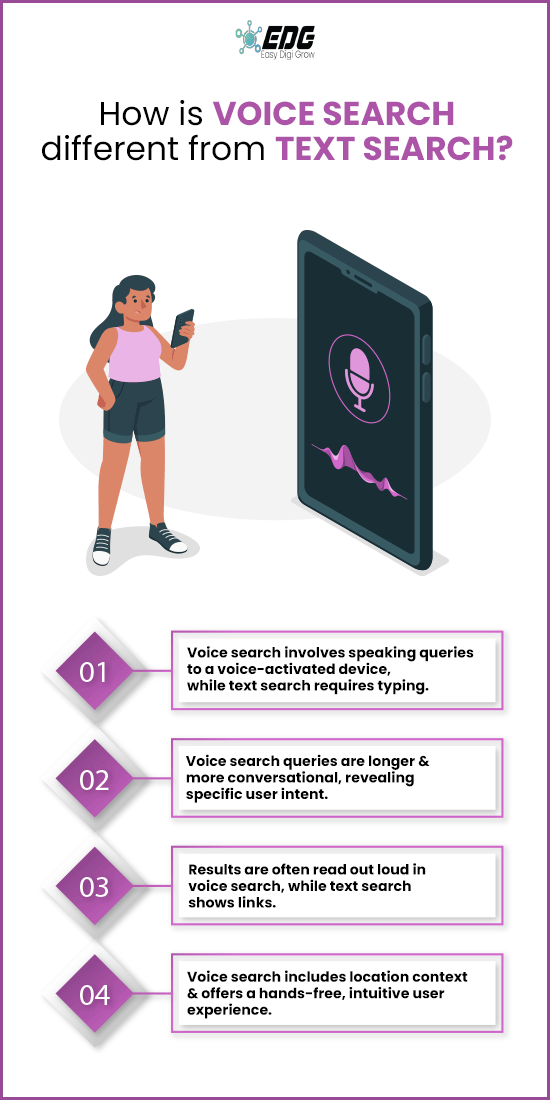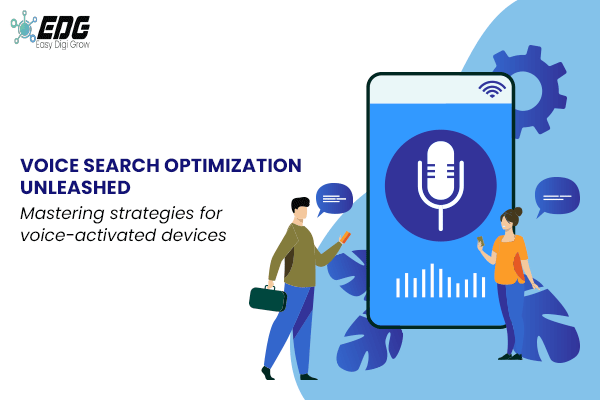In recent years, voice search has experienced an unprecedented surge in popularity, revolutionizing the way people interact with technology. With the advent of voice-activated devices like smart speakers, virtual assistants, and mobile voice search capabilities, voice search optimization has become crucial.
In this comprehensive blog, we will delve deeper into the rise of voice search, provide valuable insights and tips, and answer the most frequently asked questions regarding voice search optimization services. Voice search refers to the technology that enables users to search the internet or perform tasks on their devices using voice commands rather than traditional text-based queries. It has gained immense popularity due to its convenience and hands-free operation. Voice search optimization involves tailoring your website and content to align with the unique characteristics of voice-activated devices and user behavior. By optimizing for voice search, you can increase your chances of appearing in voice search results and reaching a wider audience. Voice-activated devices, such as Amazon Echo, Google Home, and Apple HomePod, have become household staples, with millions of users worldwide. These devices integrate virtual assistants like Alexa, Google Assistant, and Siri, respectively, making voice search an integral part of users’ daily lives. Voice search has gained immense popularity due to its convenience and ease of use. To optimize your content effectively, conduct keyword research specifically for voice search queries as a part of your on-page SEO strategy. Identify long-tail keywords and conversational phrases that users are likely to speak when using voice search. Tools like Google Keyword Planner and SEMrush can help you identify relevant voice search keywords. When optimizing your content, focus on creating conversational and natural-sounding copy that aligns with how people speak. Incorporate long-tail keywords naturally within your content, providing direct answers to common questions users may ask. Featured snippets are of utmost importance in voice search results. Aim to provide concise and informative answers to common questions about your industry or niche. Structuring your content in a format that is easily scannable by search engines can increase the likelihood of your content being selected as a featured snippet. Enhance your website’s speed to prioritize user experience and improve search engine optimization. Optimize loading speed by compressing images, minimizing CSS and JavaScript files, and implementing effective caching methods. A faster website will provide a better user experience and can positively impact your search engine rankings. Check out our local SEO guide to target your local audience for your business Craft compelling meta titles and descriptions that include relevant keywords for voice search. Ensure that they accurately summarize the content on your page and entice users to click through to your website. Implement structured data markup, such as Schema.org, to provide context to search engines about your content. This can help search engines better understand and interpret the information on your website, potentially increasing your chances of appearing as a featured snippet. As voice search is closely tied to mobile devices, ensuring that your website is fully optimized for mobile responsiveness is crucial. Use responsive website design techniques to ensure your website adapts and displays properly on various screen sizes and devices. Gain insights into voice search trends and user behavior by analyzing industry reports, conducting surveys, and leveraging tools like Google Trends. Understand the types of queries users make and the context in which they use voice search. Identify relevant long-tail keywords and conversational phrases that align with user intent. Use keyword research tools to uncover popular voice search queries and incorporate them strategically into your content. Craft content that is conversational, easy to understand, and addresses common user queries. Organize your content to deliver that provide clear and informative answers to frequently asked questions. Pay attention to technical SEO elements, such as website loading speed, mobile responsiveness, and structured data markup. Optimize these aspects to provide a seamless user experience and improve your website’s visibility in voice search results. Ensure consistent monitoring of your website’s performance in voice search results. Analyze data from tools like Google Analytics and Google Search Console to gain insights into user behavior and identify areas for improvement. The rise of voice search goes beyond information retrieval. Voice commerce, also known as v-commerce, is gaining traction as users increasingly make purchases and conduct transactions using voice-activated devices. Optimizing your e-commerce platform for voice search can help you tap into this emerging trend. With voice search expanding globally, optimizing your website for multilingual voice queries can give you a competitive advantage in international markets. Localize your content, incorporate language-specific keywords, and consider voice accent recognition for a seamless user experience. Voice-activated devices are increasingly being integrated with other smart devices in the Internet of Things ecosystem. Optimizing your strategy to leverage voice search capabilities across multiple devices, such as smart TVs, smart home appliances, and connected cars, can enhance user experiences and extend your reach. Voice search often includes location-specific queries, such as “near me” searches. Optimizing your strategy for local voice search queries can help brick-and-mortar businesses attract customers in their immediate vicinity and improve foot traffic. Voice-activated devices are becoming increasingly proficient at understanding context and providing personalized responses. Optimizing your strategy to leverage contextual understanding and personalized recommendations can enhance user interactions with your content and improve overall satisfaction. Also, check out our top website design trends to create beautiful trendy websites By understanding the nuances of voice search optimization, conducting thorough keyword research, creating conversational content, and optimizing technical aspects of your website, you can attract search engine traffic, enhance user experience, and unlock new growth opportunities. To make the most of voice search optimization, consider leveraging the expertise of professional SEO services in Delhi/NCR. EasyDigiGrow offers top-notch voice search optimization services. With our experience and knowledge in the field, we can help you optimize your website and content to align with the demands of voice-activated devices. By partnering with EasyDigiGrow, you can position your business for success in this voice-first era. The main advantages of voice search over traditional text-based search include convenience, speed, and hands-free interaction. Voice search allows users to search for information or perform tasks using natural language, making it quicker and easier compared to typing. It also enables multitasking and is especially useful in situations where using a keyboard or screen is not feasible. Various types of businesses can benefit from voice search optimization. Local businesses, such as restaurants, retail stores, and service providers, can leverage voice search to attract nearby customers searching for information like operating hours or directions. E-commerce businesses can tap into the growing trend of voice shopping. Ultimately, any business that wants to enhance its online visibility and reach a wider audience can benefit from voice search optimization. Keyword research techniques for voice search optimization differ slightly from traditional text-based search. Focus on long-tail keywords that reflect natural language queries and conversational phrases. Consider incorporating question-based keywords, local keywords, and keywords that align with the specific needs and preferences of your target audience when using voice-activated devices. To optimize your website for local voice search queries, ensure your business information is accurate and consistent across online directories, review sites, and your website. Include location-specific keywords in your content, such as city names or neighborhood references. Create localized content that addresses the needs and interests of your target audience in specific locations. Privacy concerns related to voice-activated devices are valid. These devices constantly listen for voice commands, raising potential privacy issues. It’s essential to review the privacy policies and settings of the voice-activated devices you use and be cautious about the information you share through voice interactions. Yes, voice search can be used for e-commerce transactions and online shopping. Users can search for products, check prices, add items to their shopping carts, and even complete purchases using voice-activated devices. Optimizing your e-commerce website for voice search can help you tap into this growing trend and provide a seamless shopping experience for voice users. Common challenges in optimizing for voice search include accurately understanding user intent from voice queries, adapting content to match conversational language, and optimizing for featured snippets and voice search result formats. It’s also crucial to keep up with the evolving voice search technology and user behavior patterns to stay ahead of the competition. Voice search is not limited to English. It supports other languages as well. As voice-activated devices become more advanced and accessible globally, voice search capabilities are expanding to accommodate different languages and regions. It’s important to consider multilingual voice search optimization if your target audience includes speakers of languages other than English.
Understanding Voice Search Optimization
The Growth of Voice-Activated Devices
How is Voice Search Different from Text Search?

The Importance of Voice Search Optimization
Optimizing your search engine optimization strategy for voice-activated devices offers several advantages, including:
4 Key Strategies for Voice Search Optimization
3 SEO Best Practices for Voice Search
Voice Search Optimization Guide: Step-by-Step Approach
Trends for Voice Search Optimization in 2023
Conclusion
FREQUENTLY ASKED QUESTIONS
 seolounge
seolounge

